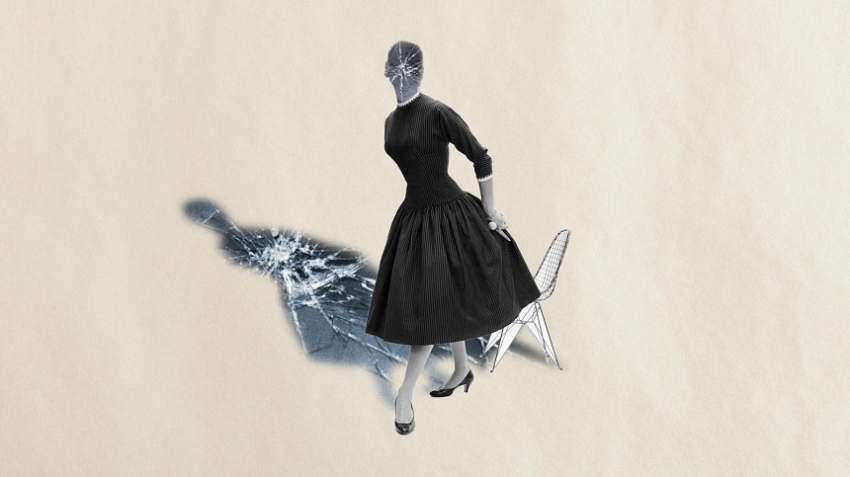It affects the health of up to 8% of women and has even been linked to outbursts of violence, but premenstrual dysphoric disorder, or PMDD, is still poorly understood. Christine Ro asks why.
As a 30-year-old, Caroline Henaghan was busy. She was working for the UK’s Home Office while training to be a barrister, and wondered if the frequent stress and anxiety she was experiencing were just products of overwork and getting older. “It felt like getting on a hamster wheel and not being able to get off,” she recalls.
Eventually work got to be too much and she took an uncharacteristic short leave of absence. But Henaghan’s mood didn’t improve. She woke up each morning with enormous anxiety, leading to social withdrawal. “I would essentially do a disappearing act so I wouldn’t have to be around people,” she says. She was never suicidal, she stresses. But she did fantasise about leaving things behind. “It would be a case of if I could go to sleep and never wake up. That’s how dramatic it was for me.”
Though the psychiatric symptoms were the strongest, there were odd physical patterns as well. Henaghan would get bloated and fatigued, sleep excessively, and – as a keen gardener – shop erratically, for instance buying plants that were out of season. Her family noticed her increasingly strange behaviour as well. She thought it might be bipolar disorder, given the cyclical nature of her ups and downs. For instance, she might spend two weeks each month putting right the damage from the previous week: the fights with loved ones, the untidy home, the slippages at work. Eventually, after what she calls a “mini-breakdown”, she realised that the recurrence of all these symptoms was linked to her menstrual cycle.
Her doctors dismissed her concerns. She visited five GPs, all male, after the first one commented: “Oh, it’s just PMS. My wife gets that.”
But it wasn’t “just” premenstrual syndrome (PMS). Henaghan had to do what many women overlooked by the medical establishment do: her own research. Through her online study, she learned about a condition called premenstrual dysphoric disorder (PMDD).
You might also like:
• How the menstrual cycle changes women’s brains
• The effect of childbirth no-one talks about
• The sexist myths that won’t die
PMDD is much more intense than its better-known relative, PMS, with physical symptoms including fatigue and migraines, while the psychological symptoms can include the severe mood swings and anxiety that plagued Henaghan. The disorder can be so debilitating that 15% of those with PMDD have attempted suicide, and some young women affected are opting for hysterectomies.
The cyclical nature of PMDD is what often distinguishes it from other mental health conditions that can trigger similar symptoms (Getty Images/Javier Hirschfeld)
Henaghan is one of them. When she was ultimately diagnosed with PMDD by a specialist, unusual experiences she’d been having since puberty finally made sense. Henaghan tried oestrogen therapy (which didn’t help) and high doses of progesterone (which helped a little). After being hospitalised for her erratic behaviour, she approached her doctor about having a total abdominal hysterectomy and bilateral salpingo oophorectomy (removal of the ovaries and fallopian tubes).
“He was very open and willing to acknowledge my own experiences,” she says. So in 2015, at the age of 36, she underwent the surgery, effectively inducing an early menopause.
PMDD is a cellular genetic malfunction in response to hormone changes, and it should be treated as the serious medical condition it is – Tory Eisenlohr-Moul
The menstrual cycle can affect the brain in both positive and negative ways as women’s hormones fluctuate. It can make them more anxious and irritable at certain points but also improve their spatial awareness and communication skills. Various studies have indicated that PMS, the symptoms some women get in the week or two before their period, is at least partially influenced by genetics and can be passed on from mothers to their daughters. And research published in 2017 also found unusual gene expression in people with PMDD that makes them unusually sensitive to oestrogen and progesterone.
“PMDD is ultimately a cellular genetic malfunction in response to hormone changes, and it should be treated as the serious medical condition that it is,” says Tory Eisenlohr-Moul, who studies women’s mental health at the University of Illinois at Chicago.
But a lack of consensus and knowledge around symptoms, whether they’re biologically, psychologically or culturally rooted, leads to PMDD being commonly misdiagnosed. The disorder was only included in the Diagnostic and Statistical Manual of Mental Disorders (DSM) in 2013, after plenty of debate.
PMDD is so murky partly because women’s health is understudied. Some sceptics are nervous about attaching another label to women that presents them as irrational. There’s also been criticism of the links between DSM subcommittee members and pharmaceutical companies amid concerns that PMS/PMDD will be pathologised and over-medicalised for profit.
The symptoms of PMDD, which can be both mental and physical, can be extreme enough to lead some women to the verge of a breakdown (Credit: Getty Images/Javier Hirschfeld)
Together this has meant that PMDD has been largely overlooked, despite the severe effect it can have on those who suffer from it. And a surprising number of women are affected. While estimates vary, there are suggestions that PMDD affects 3-8% of women of reproductive age – millions of women worldwide.
Menstrual issues have led to acquittals in shoplifting cases dating back to the 19th Century along with cases of arson, forgery, child abuse and even murder
But there is now a growing recognition of PMDD, and the mixed attitudes surrounding it, in popular culture. Megan Abbott’s latest novel Give Me Your Hand centres on a group of researchers convinced not only that PMDD exists, but that uncovering its mechanisms will make them famous. As the narrator explains of PMDD:
“At its worst, it’s led women to self-destructive acts. Or destructive ones. In the lab, we’ve all heard the horror stories: Women in its grip hitting their boyfriends over the head with frying pans, rear-ending their children’s teachers’ cars in the school parking lot. Road rage, baby shaking, worse.”
This description of PMDD is a reflection of some real-life cases where extreme premenstrual issues have been used in defences in the criminal courts. Menstrual issues have led to acquittals in shoplifting cases dating back to the 19th Century. They’ve also been raised in cases of arson, forgery, child abuse and, in the most extreme cases, murder.
Care is needed not to overstate the possible aggression associated with premenstrual issues – one lawyer estimated that if all violent crimes perpetrated by women in the US could be attributed to PMS, it would still mean that no more than 0.1% of people with PMS commit violent crimes. Clearly, even that figure is an unlikely one and Eisenlohr-Moul emphasises that “the vast majority of women have no cyclical changes in emotions, thinking or behaviour”.
But for a small minority of women who have extreme PMDD symptoms, which may include impulsivity, aggression and antisocial activities, it’s possible it can lead to some out-of-character behaviour.
Finding a doctor who will recognise PMDD can be something of a lottery as there are some in the medical profession who remain sceptical (Credit: Getty Images/Javier Hirschfeld)
The best-known case involves Sandie Craddock, a London bartender who in 1981 stabbed a co-worker. This killing was the latest crime in Craddock’s long history of arson, assault and theft, although she said that she had no clear memory of the events. Her defence pleaded diminished responsibility, producing diaries and records showing that this violence had been cyclical, and contending that her premenstrual hormonal changes were so severe that they filled her with rage. This led to a manslaughter charge.
Craddock was then placed on probation and ordered to continue progesterone treatment. That year and the following one, there were two periods where Craddock either received no progesterone or received a lower dose. The first time, she hurled a brick through a window. The second time, she attempted suicide and carried a knife to a police station. As before, she was sentenced to probation. Of course, in cases such as these it is difficult to unravel whether the drop in progesterone was directly the cause of the incidents or if she missed the medication because she was going through a difficult time more generally.
Regardless, other cases followed. The first one in the US occurred in 1991, when the surgeon Geraldine Richter was pulled over in Virginia for erratic driving. She was found to be over the alcohol limit, threatened the police officer who stopped her and tried to assault them. Eventually Richter was acquitted of drunk driving following a controversial defence that included mentioning PMS as a mitigating factor causing irritability and hostility.
In 2018, the Rajasthan High Court in India acquitted a woman of murder after she was accused of pushing three children into a well, killing one. Doctors called to court testified that the defendant had been suffering from severe PMS, making her aggressive.
It’s hard to know how often PMDD is being raised in legal cases now. Deborah Denno, a law professor at Fordham University in New York, says that in the US “there’s not a register of them, a lot are settled as plea bargains”.
In extreme cases PMDD has been linked to violence by women either towards others or themselves (Credit: Getty Images/Javier Hirschfeld)
Following her own experience with PMDD, Caroline Henaghan has herself turned to studying how premenstrual issues occur in the criminal justice system. She says that a woman who successfully pleads diminished responsibility due to a premenstrual condition is unlikely to escape criminal responsibility entirely, at least in England and Wales.
“The courts still retain control over her when it comes to sentencing and disposal,” she says. This might lead to an order to treat her condition, for example.
It should be possible to both recognise the severity and rarity of PMDD, and dismantle tired jokes and sexist misunderstandings about PMS
A chapter of Women and the Law in Australia comments that most medical experts agree that for a small minority of women, PMDD symptoms may lead to criminal actions. But much like the diagnosis itself, the legal application of PMDD is contested, and varies across jurisdictions.
To diagnose PMDD, a doctor would need two months of daily records, in order to show the periodicity of the symptoms, according to Eisenlohr-Moul. Symptoms would have to show an on/off pattern, starting one to two weeks before the period, to be diagnosable as PMDD.
For many women, however, establishing PMDD isn’t about lawyers and clinicians. Sufferers themselves are often unclear about whether they have PMDD or not. Eisenlohr-Moul says that there’s a “really high false-positive rate”, as people use PMS/PMDD as a catchall category for mysterious symptoms. This partly reflects a general tendency to trivialise women’s health, so premenstrual issues have become a convenient, through imprecise, way of lumping together lots of health conditions.
Whatever happens in the future, Eisenlohr-Moul believes that it should be possible to both recognise the severity (and rarity) of PMDD, and dismantle tired jokes and sexist misunderstandings about PMS. “We don’t need any more sitcom episodes about PMS and the idea that all women have it,” she says. What we do need is more clarity about how menstruation affects different bodies and brains.
There are some fears that PMDD and PMS could become over-medicalised by drug companies seeking to make a profit (Credit: Getty Images/Javier Hirschfeld)
Eisenlohr-Moul is contributing, for instance, by working on an app that would make it easier to automatically track and diagnose PMDD symptoms. And organisations like the International Association for Premenstrual Disorders are raising awareness of the condition. As that recognition grows, it means more women who suffer from the condition can get the help they need.
A few months following her operation, Henaghan’s symptoms faded away. “I am back to being the Caroline I was before I started suffering from PMDD symptoms,” she says happily. She has just completed a PhD at the University of Manchester, which would not have been possible if she were still in the throes of the disorder, she says.
She hopes that eventually, more GPs, endocrinologists and gynaecologists will be familiar enough with PMDD that sufferers won’t have the same experience she had, of being afraid of being labelled hysterical, or being fobbed off with leaflets about PMS.
“It’s very difficult to explain PMDD,” she reflects now. “Even when you are in the depths of PMDD, some days you struggle to identify that for yourself. It’s a very odd situation.”
--
Join one million Future fans by liking us on Facebook, or follow us on Twitter or Instagram.
If you liked this story, sign up for the weekly bbc.com features newsletter, called “The Essential List”. A handpicked selection of stories from BBC Future, Culture, Worklife, and Travel, delivered to your inbox every Friday.
Share on Facebook
Share on Twitter
Share on Linkedin
Share using Email
Open share tools
Like us on Facebook
Follow us on Twitter
Follow us on Instagram
Sign up to our newsletter
SIMILAR ARTICLES
Can wine ever really be good for us?
How cities can be good for your health
How Bhutan is stamping out an epidemic
Why children become bullies
YOU'RE READING
Why is ADHD missed in girls?
THE HEALTH GAP
PSYCHOLOGY
Share on Facebook
Share on Twitter
Share on Linkedin
Share using Email
Open share tools
SIMILAR ARTICLES
What Japan’s ‘soft power’ can teach us
How TV can be good for children
How progress bars play tricks on you
What we get wrong about time
Many more boys get diagnosed with ADHD than girls. But more girls may have the condition than we think – and their struggle to receive a diagnosis can affect their whole lives.
Author image
By Kelly Oakes
4th June 2019
Emily Johnson-Ferguson’s mind has been racing for as long as she can remember. The eating disorders she began suffering from as a teenager were her attempt to slow down her brain. Doctors tried to blame them on family problems and stress, but she knew that wasn’t it.
It was only last year, aged 42, that she finally got to the root of her problems: ADHD.
Johnson-Ferguson is not alone. Though the stereotypical image of ADHD is a boy bouncing around a classroom, that’s not the whole picture. Girls can have ADHD, too – and many go without diagnosis, and without treatment that could change their lives.
You might also like these other stories in the Health Gap:
• What is endometriosis?
• Why Alzheimer’s hits women harder than men
• The health risks of girls maturing early
ADHD is a neurodevelopmental disorder that comes in three types: inattentive, hyperactive/impulsive, or a combination of both. People with inattention may forget things, struggle to get organised, and find themselves easily distracted. Those with hyperactivity and impulsivity might struggle to stay sitting down, constantly fidget, and interrupt conversations.
Some adults with ADHD rely on multiple reminders and calendars to stay organised (Credit: Getty Images)
The condition is usually first diagnosed in childhood, but most people don’t grow out of it. For those whose symptoms are missed as children, living with undiagnosed ADHD as they move into adulthood causes problems.
“When I was left to my own devices at university I just couldn't concentrate at all,” says Johnson-Ferguson. She switched courses, but it didn’t help. Her bulimia persisted throughout university, and for the next 20 years she also used alcohol, caffeine, and sugary drinks to self-medicate – common among adults with ADHD.
As her marriage broke down, she started to find life even more difficult. In an effort to start afresh, Johnson-Ferguson gave up her bad habits, but found no respite from her symptoms; instead, they got worse. At her lowest point she was spending days on end in bed. “At that time I couldn’t focus on anything,” she says.
Attention deficit
There is a concrete difference between the prevalence of ADHD in boys versus girls. In one study of 2,332 twins and siblings, Anne Arnett, a clinical child psychologist at the University of Washington, found that a sex difference in diagnosis could be explained by differences in symptom severity: boys tended to have more extreme symptoms, and a broader distribution of symptoms, than girls.
“It's an actual neurobiological difference that we're seeing,” says Arnett. It’s not clear why that’s the case, but it could be that girls have a protective effect at the genetic level, she says.
Boys tend to have more severe ADHD symptoms, and more ADHD in general, than girls (Credit: Getty Images)
But the true size of the difference is unclear.
When it comes to real-world diagnoses, boys far outweigh girls. In studies that look at who meets ADHD criteria in the population as a whole, however, the ratio still favours boys, but less so. Depending on which research you look at, the ratio of boys to girls with ADHD could be anywhere between 2:1 and 10:1.
“It would seem to suggest that there's actually a lot more females who are affected by ADHD,” says Florence Mowlem, an associate at healthcare consultancy Aquarius Population Health. “Yet, for some reason that we don’t quite understand, they don't seem to be getting the clinical diagnosis as often as males.”
Research suggests that girls need to have more severe, and more visible, symptoms than boys before their ADHD will be recognised. In one study of 283 children aged between 7 and 12 years old, Mowlem and colleagues looked at what differentiated both boys and girls who met the diagnostic criteria for ADHD from those who had a lot of ADHD symptoms, but not enough to be diagnosed.
Parents seemed to play down girls’ hyperactive and impulsive symptoms, while playing up those of boys
Mowlem, who was PhD candidate at King’s College London at the time, found that parents, in their own ratings, seemed to play down girls’ hyperactive and impulsive symptoms, while playing up those of boys. They also found that girls who did meet the criteria tended to have more emotional or behavioural problems than girls who didn’t. This was not the case for boys.
In a similar study of 19,804 Swedish twins published last year, Mowlem and her colleagues found that girls, but not boys, were more likely to be diagnosed if they suffered from hyperactivity, impulsivity, and behavioural problems.
Girls could also be better at compensating for their ADHD symptoms than boys, similar to how girls with autism mask their symptoms.
Because of social norms, girls with ADHD are less likely to ‘bounce around the classroom’ than boys (Credit: Getty Images)
“Girls are far less likely to bounce around the classroom, fighting with the teachers and their colleagues,” says Helen Read, a consultant psychiatrist and ADHD lead for a large London NHS Trust. “A girl who did that would be so criticised by peers and other people that it is just far harder for girls to behave in that way.”
Even when they are hyperactive, girls are more likely to be over-talkative, or rebellious – a bit of a wild child, she says. That might not be recognised by parents or teachers as being caused by ADHD, especially as we expect girls to be more sociable than boys anyway.
But more research is needed before we’ll know how big a problem this is.
Symptom similarity
If girls are losing out because they have less stereotypical symptoms, they might not be the only ones: boys with purely inattentive ADHD are probably being missed, too.
It’s a commonly held belief that girls are more likely to be inattentive than boys. But that’s a myth, says Elizabeth Owens, assistant clinical professor in the department of psychology at the University of California, Berkeley. She says the current best evidence shows that rates of inattention are the same for boys and girls.
For a long, long time, ADHD in girls was discounted, or overlooked – Elizabeth Owens
“The inattentive presentation is actually more common [among both boys and girls], but it tends to be under-recognised or under-diagnosed, because the kids aren't typically causing problems in the classroom,” she adds.In fact, girls and boys with ADHD are much more similar than they are different, says Owens. “It underscores the fact that ADHD and girls is serious. For a long, long time, it was discounted, or overlooked.”One difference, though, is that girls with combined ADHD – who have both inattentive and hyperactive symptoms – are at higher risk of self-destructive actions as they enter adulthood. Girls with ADHD are also more likely to develop anxiety and depression later in life.
As part of a study that started in the 90s, Owens and her colleagues followed 228 girls, 140 of whom had ADHD, over two decades. At the second and third follow ups, when participants were on average aged 19 and 25 respectively, they found that girls who’d been diagnosed with combined ADHD in childhood were at higher risk of self-harm and attempting suicide.
In theory, recognising and treating ADHD early should help to mitigate this risk – although Owens says that, as yet, there’s no evidence to show this works. “ADHD is a chronic condition,” she says. “It's not something you can treat and it'll go away.”
For adults with ADHD, using a watch to set alerts can be helpful as a reminder to do certain things, such as eat (Credit: Getty Images)




















